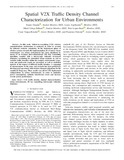Mostrar el registro sencillo del ítem
Spatial V2X traffic density channel characterization for urban environments
| dc.creator | Granda, Fausto | es_ES |
| dc.creator | Azpilicueta Fernández de las Heras, Leyre | es_ES |
| dc.creator | Celaya Echarri, Mikel | es_ES |
| dc.creator | López Iturri, Peio | es_ES |
| dc.creator | Vargas Rosales, César | es_ES |
| dc.creator | Falcone Lanas, Francisco | es_ES |
| dc.date.accessioned | 2024-01-10T07:23:01Z | |
| dc.date.available | 2024-01-10T07:23:01Z | |
| dc.date.issued | 2021 | |
| dc.identifier.citation | Granda, F., Azpilicueta, L., Celaya-Echarri, M., Lopez-Iturri, P., Vargas-Rosales, C., & Falcone, F. (2021). Spatial v2x traffic density channel characterization for urban environments. IEEE Transactions on Intelligent Transportation Systems, 22(5), 2761-2774. https://doi.org/10.1109/TITS.2020.2974692 | en |
| dc.identifier.issn | 1524-9050 | |
| dc.identifier.uri | https://hdl.handle.net/2454/46974 | |
| dc.description.abstract | In this work, Vehicle-to-everything (V2X) wireless communications performance is analyzed, in order to account for inherent scenario complexity, in the deployment phase of wireless systems towards the implementation of a Context Aware environment. An urban environment has been simulated by means of an in-house three-dimensional (3D) Ray Launching algorithm, coupled with a microscopic vehicular movement simulator, accounting for embedded urban elements as well as variable traffic densities within the complex environment. Large-scale and small-scale results are presented, as well as statistical analysis of the impact of different traffic densities. A campaign of measurements in the same real scenario has been performed, showing good agreement with wireless channel estimations for the considered frequency. These results can aid in V2X deployment configurations in urban environments, in order to minimize power consumption, optimize interference levels and increase overall system performance. | en |
| dc.description.sponsorship | This work was supported in part by the SEP-CONACyT Research Project under Grant 255387, in part by the School of Engineering and Sciences, in part by the Telecommunications and Networks Research Group, Tecnologico de Monterrey, and in part by the Departamento de Electrica, Electronica y Telecomunicaciones, Universidad de las Fuerzas Armadas ESPE. | en |
| dc.format.mimetype | application/pdf | en |
| dc.language.iso | eng | en |
| dc.publisher | IEEE | en |
| dc.relation.ispartof | IEEE Transactions on Intelligent Transportation Systems, 22(5), 2761-2774 | en |
| dc.rights | This work is licensed under a Creative Commons Attribution 4.0 License. | en |
| dc.rights.uri | http://creativecommons.org/licenses/by/4.0/ | |
| dc.subject | V2X traffic density | en |
| dc.subject | Channel characterization | en |
| dc.subject | Urban environments | en |
| dc.subject | 3D ray launching | en |
| dc.subject | Microscopic vehicular simulator | en |
| dc.title | Spatial V2X traffic density channel characterization for urban environments | en |
| dc.type | Artículo / Artikulua | es |
| dc.type | info:eu-repo/semantics/article | en |
| dc.date.updated | 2024-01-10T07:16:06Z | |
| dc.contributor.department | Ingeniería Eléctrica, Electrónica y de Comunicación | es_ES |
| dc.contributor.department | Ingeniaritza Elektrikoa, Elektronikoa eta Telekomunikazio Ingeniaritza | eu |
| dc.rights.accessRights | Acceso abierto / Sarbide irekia | es |
| dc.rights.accessRights | info:eu-repo/semantics/openAccess | en |
| dc.identifier.doi | 10.1109/TITS.2020.2974692 | |
| dc.relation.publisherversion | https://doi.org/10.1109/TITS.2020.2974692 | |
| dc.type.version | Versión publicada / Argitaratu den bertsioa | es |
| dc.type.version | info:eu-repo/semantics/publishedVersion | en |



